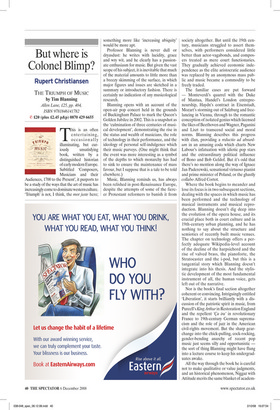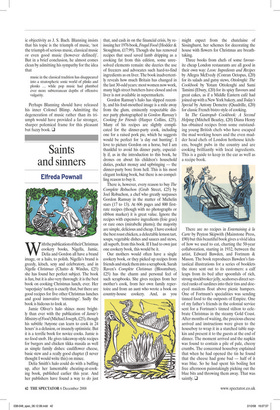But where is Colonel Blimp?
Rupert Christiansen
THE TRIUMPH OF MUSIC by Tim Blanning Allen Lane, £25, pp. 404, ISBN 9781846141782 ✆ £20 (plus £2.45 p&p) 0870 429 6655 This is an often entertaining, occasionally illuminating, but cur iously unsatisfying book, written by a distinguished historian of early modern Europe. Subtitled ‘Composers, Musicians and their Audiences, 1700 to the Present’, it purports to be a study of the ways that the art of music has increasingly come to dominate western culture. ‘Triumph’ is not, I think, the mot juste here; something more like ‘increasing ubiquity’ would be more apt.
Professor Blanning is never dull or dryasdust: he writes with lucidity, grace and wry wit, and he clearly has a passionate enthusiasm for music. But given the vast scope of his subject, it is inevitable that much of the material amounts to little more than a breezy skimming of the surface, in which major figures and issues are sketched in a summary or introductory fashion. There is certainly no indication of any musicological research.
Blanning opens with an account of the open-air pop concert held in the grounds of Buckingham Palace to mark the Queen’s Golden Jubilee in 2002. This is a snapshot as the ‘culmination of three centuries of musical development’, demonstrating the rise in the status and wealth of musicians, the role of technology in their performance, and the ideology of personal self-indulgence which their music purveys. (One might think that the event was more interesting as a symbol of the depths to which monarchy has had to sink to ensure the maintenance of mass favour, but I suppose that is a tale to be told elsewhere.) Music, Blanning reminds us, has always been relished in post-Renaissance Europe, despite the attempts of some of the fiercer Protestant reformers to banish it from society altogether. But until the 19th century, musicians struggled to assert themselves, with performers considered little better than actor-vagabonds, and composers treated as mere court functionaries. They gradually achieved economic independence as the elite aristocratic audience was replaced by an anonymous mass public and music became a commodity to be freely traded.
The familiar cases are put forward — Monteverdi’s quarrel with the Duke of Mantua, Handel’s London entrepreneurship, Haydn’s contract in Eisenstadt, Mozart’s storming out of Salzburg and freelancing in Vienna, through to the romantic conception of isolated genius which licensed the likes of Beethoven and Wagner, Paganini and Liszt to transcend social and moral norms. Blanning describes this progress with élan, providing a reductio ad absurdum in an amusing coda which charts New Labour’s infatuation with idiotic pop stars and the extraordinary political influence of Bono and Bob Geldof. But it’s odd that there’s no mention along the way of Ignace Jan Paderewski, sensational virtuoso pianist and prime minister of Poland, or the ghastly collabo Alfred Cortot.
Where the book begins to meander and lose its focus is in two subsequent sections, dealing with the spaces in which music has been performed and the technology of musical instruments and musical reproduction. Blanning doesn’t dig deep into the evolution of the opera house, and its crucial place both in court culture and in 19th-century urban planning, and he has nothing to say about the structure and semiotics of recently built music venues. The chapter on technology offers a perfectly adequate Wikipedia-level account of the decline of the harpsichord and the rise of valved brass, the pianoforte, the Stratocaster and the i-pod, but this is a tangential story which Blanning doesn’t integrate into his thesis. And the stylistic development of the most fundamental instrument of all, the human voice, gets left out of the narrative.
Nor is the book’s final section altogether coherent or convincing. Intriguingly entitled ‘Liberation’, it starts brilliantly with a discussion of the patriotic spirit in music, from Purcell’s King Arthur in Restoration England and the repellent ‘qa ira’ in revolutionary France to 19th-century German supremacism and the role of jazz in the American civil-rights movement. But the sharp gearchange into the chick-pulling, cock-rocking, gender-bending anarchy of recent pop music just seems silly and opportunistic — the sort of thing Blanning might have flung into a lecture course to keep his undergraduates awake.
All the way through the book he is careful not to make qualitative or value judgments, and an historical phenomenon, Niggaz with Attitude merits the same blanket of academ ic objectivity as J. S. Bach. Blanning insists that his topic is the triumph of music, ‘not the triumph of serious music, classical music or even good music (however defined)’. But in a brief conclusion, he almost comes clean by admitting his sympathy for the idea that
music in the classical tradition has disappeared into a stratospheric sonic world of plinks and plonks ... while pop music had plumbed ever more subterranean depths of offensive vulgarity.
Perhaps Blanning should have released his inner Colonel Blimp. Admitting the degeneration of music rather than its triumph would have provided a far stronger, sharper polemical frame for this pleasant but fuzzy book. ❑



















































































 Previous page
Previous page